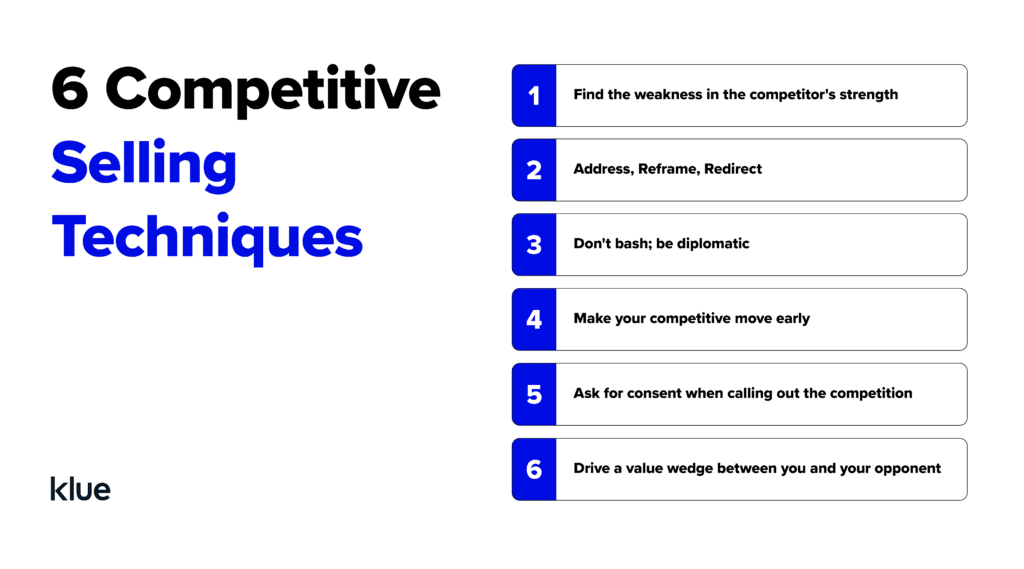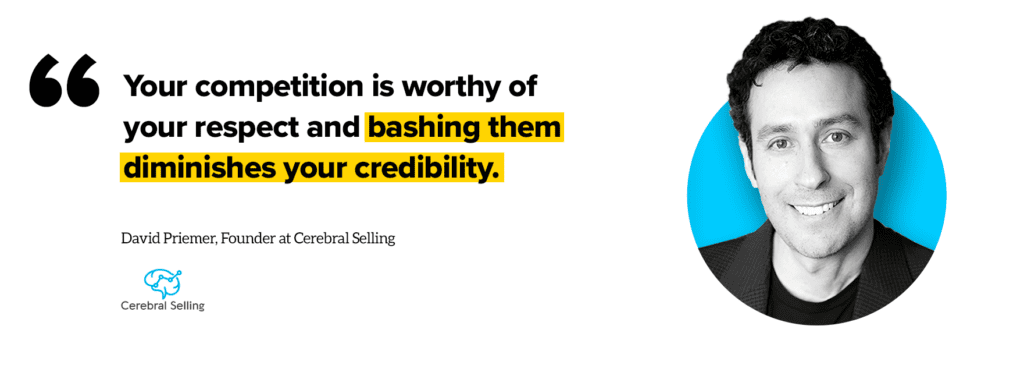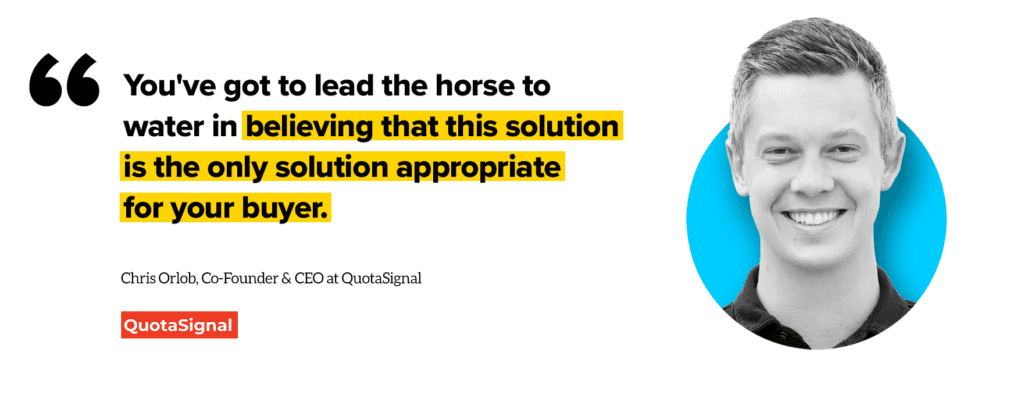Klue Compete
The Competitive Enablement Platform
Learn More
FIND OUT MORE >

There’s nothing like the head-to-head battle of competitive selling.
Just like playing heads up in poker, staring a pitcher down on the mound or two boxers squaring off in the ring — it’s the peak of competition.
Poker players, boxers and baseball players all have competitive techniques they swear by to help them beat the competition. Competitive sellers do too.
Here are six competitive selling techniques from some of the best sellers around.


Weaknesses can be fixed. Especially if that weakness is a feature or function. The moment your competitors’ weaknesses get stronger, you’ve lost that point of differentiation.
A competitive selling technique that sellers don’t leverage enough is finding the weakness in their competitor’s strength. The thing that you know they’ll be beating the drum about in a sales call.
It’s a tactic Chris Orlob, for Head of Sales at Gong, trained his reps to lean into when competing with Chorus.
“Back in the early days of Gong and Chorus, Chorus would lean into the fact they were in an AI company. So we went to market in sales conversations acknowledging their strength, but then we turned it on its head,” Chris said on a recent episode of the Competitive Enablement Show.
Gong used that strength as an opportunity to attack. If Chorus was built by AI, how could it truly capture all the nuances in the life of a seller?
This doubt and uncertainty around what Chorus was touting as their main strength proved to be a highly valuable selling technique.


Objection handling in sales can feel a lot like stick-handling a puck through pylons. The ARR framework is a competitive selling framework that helps you identify and categorize an objection, and find the right approach to overcome that objection.
ADDRESS this objection head on. Demonstrate the claim is false using third-party validation.
ADDRESS it directly. Not only are these kinds of claims or objections easily disprovable, use them as a competitive selling technique to suggest your competitor hasn’t done their homework.
REFRAME a claim like this by first acknowledging the partial truth, followed by turning it around and showing how your solution is better for the buyer’s issue.
REFRAME this objection by not falling into the irrelevant part of the claim. Bring the conversation back on track by pointing to your main differentiators.
REDIRECT this claim away from the valid objection made against your solution and back towards your strengths.
Looking for more objection handling wisdom? Check out our on-demand webinar here.


The more you keep your conversations above board, respectful and honest, the better chance you have of leaving a good impression on the buyer.
While that won’t guarantee a closed deal, it certainly doesn’t hurt.
Even your arch-rival competitors have customers who love them, explains sales coach and author David Premier.


“Your competition is worthy of your respect and bashing them diminishes your sense of professionalism.”
Don’t be afraid to praise your competitor when it’s factually true. If they have a kick-ass Salesforce integration, acknowledge it. You can do so without tipping the deal in their favour.
Deals are won and lost on how you demonstrate your value in being able to solve the buyer’s problems. Not a shiny feature.
If you wait until the latter half of the deal to make a competitive action, it’s already too late.
You need to be proactive, explains Chris Orlob.
During his time at Gong, Chris made sure every one of his sellers was proactively gaining an advantage against Chorus, whether they were explicitly in the deal or not.
What does that look like?
It starts with knowing what your most important differentiators are. In Gong’s case, sellers preferred their interface.
Then it turns into a competitive action in the field.
“I’m going to recommend a pilot so that we can showcase our usage stats. Mine are going to look a lot better than Chorus’. Then I’ll pull that usage report to showcase what your sellers are using.”
It’s not enough to just know your differentiators. It’s about proactively bringing them into your sales cycle.


Your main competitor being in a deal can feel like the elephant in the room. Some sellers and buyers alike don’t respond well to the direct confrontation of us versus them.
So Klue Account Executive Leigh Quinlan asks for consent as a competitive selling technique.
“Oftentimes you don’t want to come off too salesy or too aggressive. And so it really helped me kind of segue into that conversation with prospects.”
Once the permission to differentiate is given, you’ve got full leeway to juxtapose your value against the competitors’ (and knock them out of the deal).
Know your unique differentiators; know your competitors’. The last piece of the puzzle is knowing what’s most important to your prospect.
When you match up the factors that are important to your prospect with the unique differentiators you can offer… bingo. You have what we at Klue call, a value wedge.
Think of the value wedge as a competitive Venn Diagram: on one bubble is what your prospect values most. The other bubble is your unique differentiators. When there’s an overlap of the two, there’s your value wedge.
“I have seven to 10 unique differentiators at a high level that I can pick and pluck from based on what’s important to my prospect,” says Klue Account Executive, Qayam Noorani.
Qayam recommends leaning on the two-to-three most relevant differentiators. The more you can drive a prospect’s questions or objections back to your value wedge, the more successful you’ll be.
If you made it this far then you’re serious about outselling the competition.
And you’re in luck. We’ve partnered with 30 Minutes to President’s Club to provide the best trap questions to ask, how to land them, and the battlecard framework to use to do so.
Get your hands on the toolkit here.




Competitive Enablement
The topic of Large Language Models (LLMs) has a lot of confusion. Here's what you need to know about how Klue is working with them.


Competitive Enablement
Product Marketing
If your competitive intel game is too strong for automation, too pure for data privacy, and too rebellious for accuracy — then Klue AI is probably not for you.


Let’s do it. Tell us a bit about yourself and we’ll set up a time to wow you.
Let's do it. Tell us a bit about yourself and we'll set up a time to wow you.
XLet's do it. Tell us a bit about yourself and we'll set up a time to wow you.
XSubscribe to get our latest AI functionality and news in your inbox.
XOur Buyer Pulse feature, set to launch in Q2 2024, offers valuable insights into the factors influencing buyer decisions in your pipeline. By signing up for the waitlist, we can better gauge interest and proactively engage with you to streamline the setup and integration process before the feature becomes widely available.
X